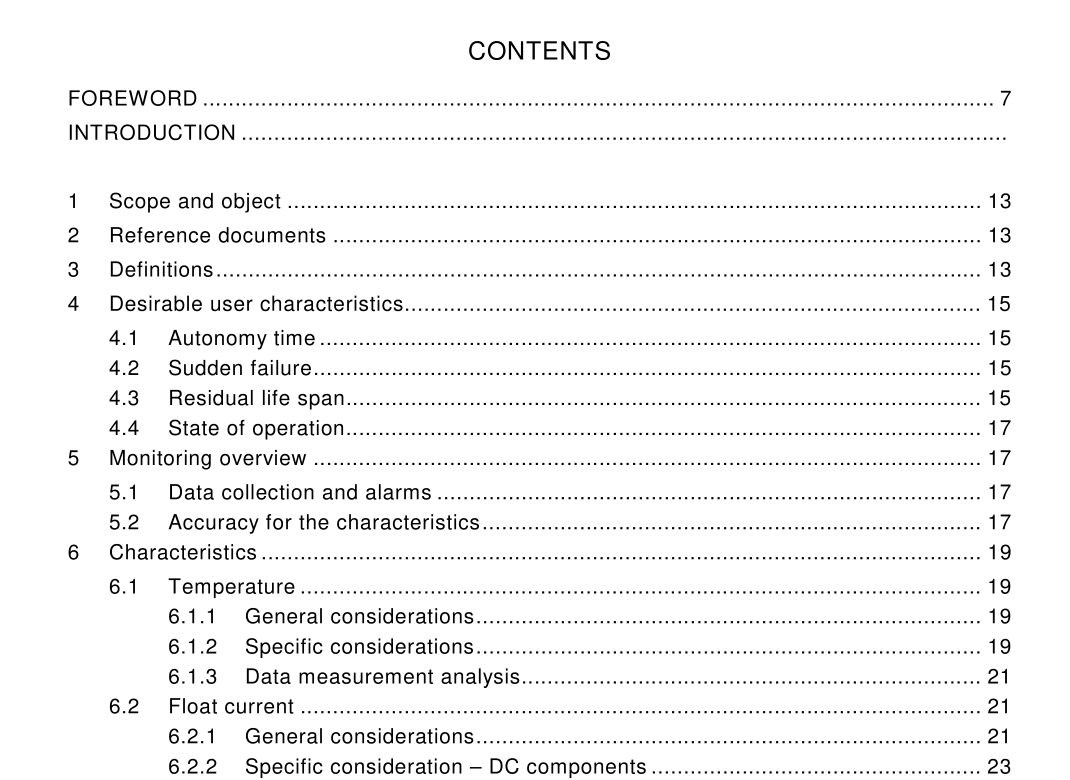IEC 62060 pdf download

IEC 62060 pdf download.Secondary cells and batteries – Monitoring of lead acid stationary batteries – User guide
1 Scope and object
This technical report is applicable to lead-acid vented and valve regulated batteries, for use in stationary battery applications. The object of this technical report is: – to assist users in the selection of methods to obtain sufficient information to indicate the state of health of an operating stationary lead-acid battery; – to achieve this by describing characteristics that can be electrically measured and remotely interrogated on a regular basis; – to indicate the sensitivity and reliability of the measured data and to provide the user with methods of interpretation; – to provide users with good operating characteristics and general guidelines.
2 Reference documents
IEC 60896 (all parts), Stationary lead-acid batteries ETS 300 1 32-2, Equipment Engineering (EE) – Power supply interface at the input to telecommunications equipment – Part 2: Operated by direct current (dc) ETS 300 253, Equipment Engineering (EE) – Earthing and bonding of telecommunication equipment in telecommunication centres ETS 300 386-1 , Equipment Engineering (EE) – Telecommunication network equipment – Electro-Magnetic Compatibility (EMC) requirements – Part 1 : Product family overview, compliance criteria and test levels
3 Definitions
For the purpose of this technical report, the following definitions apply: 3.1 VLA cell or battery vented lead-acid cell or battery 3.2 VRLA cell or battery valve regulated lead-acid cell or battery 3.3 online discharge discharge of a battery through its connected load by reducing the charger voltage such that the charger supplies no current to the load 3.4 residual life span remaining period of useful life of a battery in service 3.5 d.c. resistance quotient of direct battery voltage by direct battery current as measured by d.c. techniques 3.6 a.c. resistance the real resistive component of the battery impedance 3.7 impedance quotient of the fundamental component of the battery voltage by the sinusoidal battery current as measured by a.c. techniques
4 Desirable user characteristics
4.1 Autonomy time The capability of the battery to give its design run time at the claimed power level is a very important characteristic for the user. The direct way to determine this capability is to perform a capacity test, but this will only establish the autonomy time capability at the time of the test. Capacity testing is however undesirable in a monitoring environment, and estimates of autonomy will have to be derived from load tests or a.c./d.c. resistance or conductance characteristics.4.2 Sudden failure The risk of sudden failure of the battery is equally important to the user. The most common source of sudden failure arises from either a short circuit or an open circuit in the battery. These conditions may be detected from changes of voltage, current, temperature and a.c./d.c. resistance, against time. It should be noted however that sudden failure may not be detected in the float condition but may become apparent in any subsequent discharge. 4.3 Residual life span Residual life span is probably the most difficult user characteristic to evaluate. However, quantifying residual life span is very important for security purposes and identifying the optimum time for battery replacement. Indications of residual life span can be derived from regularly recorded a.c./d.c. resistance or conductance data and load tests. In addition, knowing the actual life span of the battery under standard conditions, it is possible to estimate residual life span using time – temperature data.4.4 State of operation The state of operation establishes for the user that the battery is operating within agreed parameters. The necessary monitor information required to determine the state of battery operation can be obtained from battery voltage, battery charge current and battery temperature.









